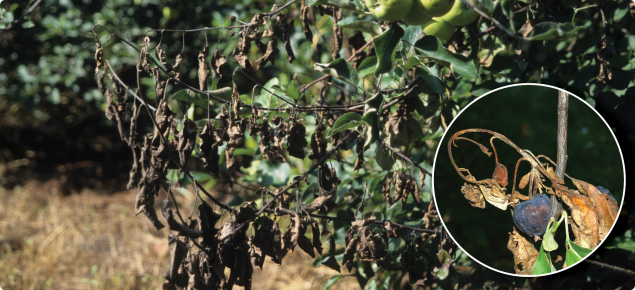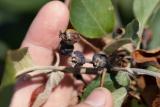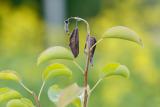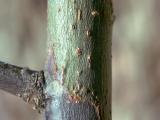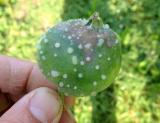What plants are affected?
- Fruit trees: apples, pears, quince, loquat, plum and apricot.
- Berries: raspberries and blackberries.
- Ornamentals: Crab apple, photinia, ornamental prunus, rose and other plants in the rose family.
What do I look for?
- Plants look as if they have scorched or burnt, hence the name “fire blight”.
- Blossoms, shoots and leaves wilt and turn brown or black.
- Shoots and branches bend into a ‘shepherd’s crook’ shape.
- Discoloured sunken areas, cankers and cracks appear on branches, trunks and rootstock.
- Bacterial ooze seeps out of cankers and infected fruit when the weather is warm and humid.
How does the disease survive and spread?
- Fire blight bacteria ooze out of the infected tissues of host plants.
- The bacterial exudates can spread locally by wind, rain, insects and birds or when plants rub against each other.
- Fire blight enters the plant through surface injuries caused by insect feeding, hail and mechanical damage or through natural openings in the flowers.
- Bees can introduce the bacteria to blossoms during pollination.
- Fire blight travels long distances on infected plant material or on contaminated equipment or people.
- The bacteria overwinter in cankers formed on infected limbs or twigs.
What damage can this pest cause?
Fire blight reduces apple and pear production and whole orchards can be destroyed. Fire blight also attacks ornamental plants and berries causing losses in nurseries and gardens. There is no cure for fire blight.
Status in Western Australia
Fire blight (Erwinia amylovora) is absent from Western Australia and is a quarantine pest. It is a prohibited organism under section 12 of the Biosecurity and Agriculture Management Act 2007.
Western Australia's Pest Freedom for fire blight is supported by general and specific surveillance and specific import requirements to prevent its entry. A person who finds or suspects the presence of fire blight in orchards, nurseries or urban areas must report it to DPIRD.
What do I do if I find it?
Early detection and eradication will help protect Western Australia’s fruit production and nursery industries. If you find or suspect plants with fire blight, please make a report using MyPestGuide® or contact the Pest and Disease Information Service (PaDIS) to report this pest. Do not disturb the plant. Do not move, compost or dispose of suspect plants.
Report your observations
 | MyPestGuide® Reporter Pest and Disease Information Service |

